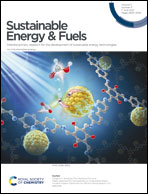Zinc-electrocatalyzed hydrogenation of furfural in near-neutral electrolytes†
Abstract
Electrocatalytic hydrogenation (ECH) of biomass-derived platform chemicals is a sustainable approach to produce value added fuels and chemicals as compared to the chemo-catalytic hydrogenation pathway. In this work, zinc metal was studied as a novel electrocatalyst for potentiostatic ECH of furfural to furfuryl alcohol (FAL) and 2-methylfuran (MF), products having applications in pharmaceutical, polymer and fuel industries. The activity of zinc was compared to that of other well-known catalysts, copper and nickel. The yield and faradaic efficiency (FE) of furfural ECH was studied for varying electrolyte pH, which was found to significantly affect the FE and product profile. Electrolysis in near-neutral electrolyte (pH 6 to 8) exhibited increased yields and FE as compared to under acidic and alkaline conditions. We attribute this result to the optimum proton concentration in neutral electrolytes that restricts the HER while minimizing side reactions. At neutral pH, the reaction was more selective towards FAL formation than MF. The best activity of the zinc catalyst was obtained with 0.5 M sodium bicarbonate (NaHCO3) electrolyte (pH = 8.4) at −0.7 V/RHE, yielding 73% FE for FAL and 86% FE overall. To the best of our knowledge, this is the highest FE for FAL that has been reported to date. Oxidation of zinc was observed during electrolysis, only in the presence of furfural, suggesting that oxidized zinc may play a role in the reaction mechanism.

- This article is part of the themed collection: Recent Open Access Articles


 Please wait while we load your content...
Please wait while we load your content...